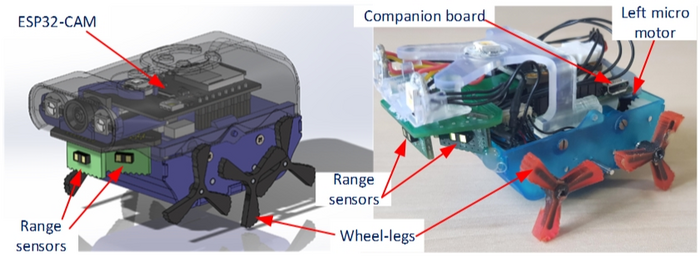A maze of pipes and conduits for water, sewage, and gas can be found beneath the streets. Regular monitoring of these pipes for leakage or maintenance usually necessitates these to be dug up. The latter is not only laborious and costly (an estimated yearly cost of £5.5 billion in the UK alone), but it also causes traffic inconvenience and annoyance to individuals living nearby, not to mention environmental damage.
 Layout of the autonomous Joey mini-robot. Image Credit: TL Nguyen, A Blight, A Pickering, A Barber, GH Jackson-Mills, JH Boyle, R Richardson, M Dogar, N Cohen
Layout of the autonomous Joey mini-robot. Image Credit: TL Nguyen, A Blight, A Pickering, A Barber, GH Jackson-Mills, JH Boyle, R Richardson, M Dogar, N Cohen
Imagine a robot that can navigate the tightest of pipe networks and send images of damage or blockages to human operators. This is no longer just a dream, according to a new study published in Frontiers in Robotics and AI by a team of scientists from the University of Leeds.
Here we present Joey—a new miniature robot—and show that Joeys can explore real pipe networks completely on their own, without even needing a camera to navigate.
Dr. Netta Cohen, Study Final Author and Professor, University of Leeds
Joey is the first robot that is capable of navigating mazes of pipes as narrow as 7.5 cm on its own. It weighs only 70 g and is small enough to nestle in the palm of the hand.
Pipebots Project
The current effort is part of the “Pipebots” project, a cooperation between the universities of Sheffield, Bristol, Birmingham, and Leeds, as well as UK utility corporations and other international academic and industrial partners.
Underground water and sewer networks are some of the least hospitable environments, not only for humans, but also for robots. Sat Nav is not accessible undergound. And Joeys are tiny, so have to function with very simple motors, sensors, and computers that take little space, while the small batteries must be able to operate for long enough.
Dr. Thanh Luan Nguyen, Study First Author and Postdoctoral Scientist, University of Leeds
Dr. Thanh Luan Nguyen developed Joey’s control algorithms (or “brain”).
Joey moves around on 3D-printed “wheel-legs,” which roll over straight parts and walk over tiny obstacles. It has a variety of energy-efficient sensors that detect its distance to walls, junctions, and corners, navigational tools, a microphone, and a camera with “spotlights” to record and save defects in the pipe network. The prototype only costs approximately £300 to make.
Mud and Slippery Slopes
Joey was capable of navigating an experimental network of pipes that included a T-junction, a left and right corner, a dead-end, an obstacle, and three straight segments without the assistance of human operators. Joey explored nearly 1 m of pipe network in an average of just 45 seconds.
To make the robot’s life more challenging, the researchers demonstrated that the robot can navigate up and down inclined pipes with realistic slopes. They also introduced sand and gooey gel (really dishwashing liquid) to the pipes to test Joey’s ability to maneuver through muddy or slippery tubes, with success.
Significantly, the sensors help Joey navigate the pipes without the assistance of a camera or power-hungry computer vision. This saves energy and extends the life of Joey’s current battery. When the battery runs out, Joey will return to its starting point to “feed” on power.
Joey, however, has one flaw: it cannot right itself if it accidentally turns on its back, like an upside-down tortoise. According to the authors, the next prototype will be able to overcome this issue. In the future, the researchers hope to make Joey waterproof and to be able to function underwater in liquid-filled pipelines.
Joey’s Future is Collaborative
Based on a larger “mother” robot dubbed Kanga, the Pipebot scientists hope to create a swarm of Joeys that communicate and collaborate. Kanga, which is now being developed and tested by some of the same authors at Leeds School of Computing, will be endowed with more advanced sensors and repair tools like robot arms, as well as the ability to carry numerous Joeys.
Cohen says, “Ultimately we hope to design a system that can inspect and map the condition of extensive pipe networks, monitor the pipes over time, and even execute some maintenance and repair tasks.”
We envision the technology to scale up and diversify, creating an ecology of multi-species of robots that collaborate underground. In this scenario, groups of Joeys would be deployed by larger robots that have more power and capabilities but are restricted to the larger pipes. Meeting this challenge will require more research, development, and testing over 10 to 20 years. It may start to come into play around 2040 or 2050.
Dr. Netta Cohen, Study Final Author and Professor, University of Leeds
Journal Reference:
Nguyen, T. L., et al. (2022) Autonomous control for miniaturized mobile robots in unknown pipe networks. Frontiers in Robotics and AI. doi.org/10.3389/frobt.2022.997415.